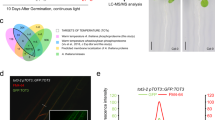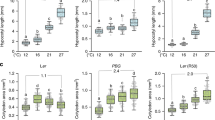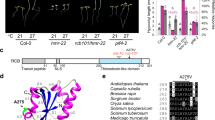Abstract
To acquire freezing tolerance, higher plants require a period of low temperature (usually <4 °C) termed cold acclimation. Upon transfer of plants to low temperature, increased expression of the CRT/DRE binding factor (CBF) family of transcriptional activators leads to the upregulation of genes containing a C-repeat/drought-responsive (CRT/DRE) promoter element and metabolic changes that enhance tolerance to subzero temperatures1. Here, we show that a low red to far-red ratio (R/FR) light signal increases CBF gene expression in Arabidopsis thaliana in a manner dependent on the circadian clock. This light quality–dependent increase in CBF expression is sufficient to confer freezing tolerance at temperatures higher than those required for cold acclimation. Furthermore, the use of light-quality signals to stimulate CBF expression has revealed ambient temperature–dependent coupling of CBF transcription factors to downstream CO LD R EGULATED (COR) genes, providing evidence for a second temperature-regulated step in this pathway.
This is a preview of subscription content, access via your institution
Access options
Subscribe to this journal
Receive 12 print issues and online access
$209.00 per year
only $17.42 per issue
Buy this article
- Purchase on Springer Link
- Instant access to full article PDF
Prices may be subject to local taxes which are calculated during checkout






Similar content being viewed by others
Accession codes
References
Thomashow, M.F. Plant cold acclimation: freezing tolerance genes and regulatory mechanisms. Annu. Rev. Plant Physiol. Plant Mol. Biol. 50, 571–599 (1999).
Franklin, K.A. & Whitelam, G.C. Phytochromes and shade avoidance responses in plants. Ann. Bot. (Lond.) 96, 169–175 (2005).
Linkosalo, T. & Lechowicz, M. Twilight far-red treatment advances leaf bud burst of silver birch (Betula pendula). Tree Physiol. 26, 1249–1256 (2006).
Halliday, K.J., Salter, M.G., Thingnaes, E. & Whitelam, G.C. Phytochrome control of flowering is temperature sensitive and correlates with expression of the floral integrator FT. Plant J. 33, 875–885 (2003).
Halliday, K.J. & Whitelam, G.C. Changes in photoperiod or temperature alter the functional relationships between phytochromes and reveal roles for phyD and phyE. Plant Physiol. 131, 1913–1920 (2003).
Johnson, E., Bradley, J.M., Harberd, N.P. & Whitelam, G.C. Photoresponses of light-grown phyA mutants of Arabidopsis: phytochrome A is required for the perception of daylength extensions. Plant Physiol. 105, 141–149 (1994).
Salter, M.G., Franklin, K.A. & Whitelam, G.C. Gating of the rapid shade avoidance response by the circadian clock in plants. Nature 426, 680–683 (2003).
Carabelli, M., Sessa, G., Ruberti, I. & Morelli, G. The Arabidopsis ATHB-2 and -4 genes are strongly induced by far-red-rich light. Plant J. 4, 469–479 (1993).
Gilmour, S.J. et al. Low temperature regulation of the Arabidopsis CBF family of AP2 transcriptional activators as an early step in cold-induced COR gene expression. Plant J. 16, 433–442 (1998).
Knight, H., Zarka, D.G., Okamoto, H., Thomashow, M.F. & Knight, M.R. Abscisic acid induces CBF gene transcription and subsequent induction of cold-regulated genes via the CRT promoter element. Plant Physiol. 135, 1710–1717 (2004).
Söderman, E., Mattsson, J. & Engström, P. The Arabidopsis homeobox gene ATHB-7 is induced by water deficit and by abscisic acid. Plant J. 10, 375–381 (1996).
Abe, H. et al. Role of Arabidopsis MYC and MYB homologs in drought and abscisic acid-regulated gene expression. Plant Cell 9, 1859–1868 (1997).
Vogel, J.T., Zarka, D.G., Van Buskirk, H.A., Fowler, S.G. & Thomashow, M.F. Roles of the CBF2 and ZAT12 transcription factors in configuring the low temperature transcriptomes of Arabidopsis. Plant J. 41, 195–211 (2005).
Franklin, K.A. et al. Phytochromes B, D and E act redundantly to control multiple physiological responses in Arabidopsis. Plant Physiol. 131, 1340–1346 (2003).
Sharrock, R.A. & Clack, T. Heterodimerization of type II phytochromes in Arabidopsis. Proc. Natl. Acad. Sci. USA 101, 11500–11505 (2004).
Kim, H.-J., Kim, Y.-K. & Kim, J. Light signaling mediated by phytochrome plays an important role in cold-induced gene expression through the C-repeat/dehydration responsive element (C/DRE) in Arabidopsis thaliana. Plant J. 29, 693–704 (2002).
Edwards, K.D. et al. Flowering Locus C mediates natural variation in the high-temperature response of the Arabidopsis circadian clock. Plant Cell 18, 639–650 (2006).
Harmer, S.L. et al. Orchestrated transcription of key pathways in Arabidopsis by the circadian clock. Science 290, 2110–2113 (2000).
Fowler, S.G., Cook, D. & Thomashow, M.F. Low temperature induction of Arabidopsis CBF1,2, and 3 is gated by the circadian clock. Plant Physiol. 137, 961–968 (2005).
Gilmour, S.J., Fowler, S.G. & Thomashow, M.F. Arabidopsis transcriptional activators CBF1, CBF2 and CBF3 have matching functional activities. Plant Mol. Biol. 54, 767–781 (2004).
Zarka, D.G., Vogel, J.T., Cook, D. & Thomashow, M.F. Cold induction of Arabidopsis CBF genes involves multiple ICE (Inducer of CBF Expression) promoter elements and a cold-regulatory circuit that is desensitized by low temperature. Plant Physiol. 133, 910–918 (2003).
Knight, H., Veale, E., Warren, G. & Knight, M.R. The sfr6 mutation in Arabidopsis suppresses low temperature induction of genes dependent on the CRT/DRE sequence motif. Plant Cell 11, 875–886 (1999).
Kim, H.-J. et al. A genetic link between cold responses and flowering time through FVE in Arabidopsis thaliana. Nat. Genet. 36, 167–171 (2004).
Blázquez, M.A., Ahn, J.H. & Weigel, D. A thermosensory pathway controlling flowering time in Arabidopsis thaliana. Nat. Genet. 33, 168–171 (2003).
Ausín, I., Alonso-Blanco, C., Jarillo, J.A., Ruiz-García, L. & Martínez-Zapater, J.M. Regulation of flowering time by FVE, a retinoblastoma-associated protein. Nat. Genet. 36, 162–166 (2004).
Amasino, R. Take a cold flower. Nat. Genet. 36, 111–112 (2004).
Jaglo-Ottosen, K.R., Gilmour, S.J., Zarka, D.G., Schabenberger, O. & Thomashow, M.F. Arabidopsis CBF1 overexpression induces COR genes and enhances freezing tolerance. Science 280, 104–106 (1998).
Whitelam, G.C. et al. Phytochrome A null mutants of Arabidopsis display a wild-type phenotype in white light. Plant Cell 5, 757–768 (1993).
Acknowledgements
The authors thank M. Knight and H. Knight for provision of sfr6 seed. This work has been supported by grants from the UK Biotechnology and Biological Sciences Research Council to G.C.W. and K.A.F. and from the Royal Society to K.A.F. K.A.F. is a Royal Society University Research Fellow.
Author information
Authors and Affiliations
Contributions
K.A.F. carried out all the experimental work. G.C.W. and K.A.F. contributed equally to experimental design and interpretation.
Corresponding author
Supplementary information
Supplementary Text and Figures
Supplementary Figures 1–3, Supplementary Table 1 (PDF 67 kb)
Rights and permissions
About this article
Cite this article
Franklin, K., Whitelam, G. Light-quality regulation of freezing tolerance in Arabidopsis thaliana. Nat Genet 39, 1410–1413 (2007). https://doi.org/10.1038/ng.2007.3
Received:
Accepted:
Published:
Issue Date:
DOI: https://doi.org/10.1038/ng.2007.3
This article is cited by
-
Microtubules as a potential platform for energy transfer in biological systems: a target for implementing individualized, dynamic variability patterns to improve organ function
Molecular and Cellular Biochemistry (2023)
-
Comparative transcriptomic analyses of citrus cold-resistant vs. sensitive rootstocks might suggest a relevant role of ABA signaling in triggering cold scion adaption
BMC Plant Biology (2022)
-
Genome wide association study of frost tolerance in wheat
Scientific Reports (2022)
-
Association mapping of autumn-seeded rye (Secale cereale L.) reveals genetic linkages between genes controlling winter hardiness and plant development
Scientific Reports (2022)
-
PIFs- and COP1-HY5-mediated temperature signaling in higher plants
Stress Biology (2022)



